Manual for Package pgfplots
2D/3D Plots in LATeX, Version 1.18.2
https://github.com/pgf-tikz/pgfplots
PGFplotsTable
6.3Generating Data in New Tables or Columns
It is possible to create new tables from scratch or to change tables after they have been loaded from disk.
6.3.1Creating New Tables From Scratch¶
-
\pgfplotstablenew[
 options
options ]{
]{ row count
row count }{
}{ \table
\table }
¶
}
¶
-
\pgfplotstablenew*[
 options
options ]{
]{ row count
row count }{
}{ \table
\table }
}
Creates a new table from scratch.
The new table will contain all columns listed in the
columns key. For
\pgfplotstablenew, the columns key needs to be provided in
[ options
options ]. For \pgfplotstablenew*, the current
value of columns is used, no matter where and
when it has been set.
]. For \pgfplotstablenew*, the current
value of columns is used, no matter where and
when it has been set.
Furthermore, there must be create on use statements (see the next subsection) for every column which shall be generated.106 Columns are generated independently, in the order of appearance in columns. As soon as a column is complete, it can be accessed using any of the basic level access mechanisms. Thus, you can build columns which depend on each other.
The table will contain exactly
 row count
row count rows. If
rows. If
 row count
row count is an
\pgfplotstablegetrowsof
statement, that statement will be executed and the resulting number of rows be used. Otherwise,
is an
\pgfplotstablegetrowsof
statement, that statement will be executed and the resulting number of rows be used. Otherwise,
 row count
row count will be evaluated as number.
will be evaluated as number.

% this key setting could be provided in the document's preamble:
\pgfplotstableset{
% define how the 'new' column shall be filled:
create on use/new/.style={create col/set list={4,5,6,7,...,10}}}
% create a new table with 11 rows and column 'new':
\pgfplotstablenew[columns={new}]{11}\loadedtable
% show it:
\pgfplotstabletypeset[empty cells with={---}]\loadedtable

% create a new table with 11 rows and column 'new':
\pgfplotstablenew[
% define how the 'new' column shall be filled:
create on use/new/.style={create col/expr={factorial(15+\pgfplotstablerow)}},
columns={new}]
{11}
\loadedtable
% show it:
\pgfplotstabletypeset\loadedtable
-
\pgfplotstablevertcat{
 \table1
\table1 }{
}{ \table2 or filename
\table2 or filename }
¶
}
¶
Appends the contents of
 \table2
\table2 to
to
 \table1
\table1 (“vertical concatenation”). To be more precise, only columns which exist already in
(“vertical concatenation”). To be more precise, only columns which exist already in
 \table1
\table1 will be appended and every column which exists in
will be appended and every column which exists in
 \table1
\table1 must exist in
must exist in
 \table2
\table2 (or there must be alias or
create on use specifications to generate
them).
(or there must be alias or
create on use specifications to generate
them).
If the second argument is a file name, that file will be loaded from disk.
If
 \table1
\table1 does not exist,
does not exist,
 \table2
\table2 will be copied to
will be copied to
 \table1
\table1 .
.
\pgfplotstablevertcat{\output}{datafile1} % loads `datafile1' -> `\output'
\pgfplotstablevertcat{\output}{datafile2} % appends rows of datafile2
\pgfplotstablevertcat{\output}{datafile3} % appends rows of datafile3
The output table
 \table1
\table1 will be defined in the current
TeX
scope and it will be erased afterwards. The current
TeX
scope is delimited by an extra set of curly braces. However, every
LaTeX
environment and, unfortunately, the TikZ
\foreach statement as well, introduce
TeX
scopes.
will be defined in the current
TeX
scope and it will be erased afterwards. The current
TeX
scope is delimited by an extra set of curly braces. However, every
LaTeX
environment and, unfortunately, the TikZ
\foreach statement as well, introduce
TeX
scopes.
pgfplots has some some loop statements which do not introduce extra scopes. For example,
\pgfplotsforeachungrouped \i in {1,2,...,10} {%
\pgfplotstablevertcat{\output}{datafile\i} % appends `datafile\i' -> `\output'
}%
These looping macros are explained in the manual of pgfplots, reference section “Miscellaneous Commands”
-
\pgfplotstableclear{
 \table
\table }
¶
}
¶
Clears a table. Note that it is much more reliable to introduce extra curly braces ‘{ ... }’ around table operations – these braces define the scope of a variable (including tables).
106 Currently, you need to provide at least one column: the implementation gets confused for completely empty tables. If you do not provide any column name, a dummy column will be created.
6.3.2Creating New Columns From Existing Ones¶
-
\pgfplotstablecreatecol[
 options
options ]{
]{ new col name
new col name }{
}{ \table
\table }
¶
}
¶
-
1. \prevrow{
 col name
col name } / \getprevrow{
} / \getprevrow{ col name
col name }{
}{ \macro
\macro }
}
These two routines return the value stored in the previous row of the designated column
 col name
col name . The get routine stores it into
. The get routine stores it into
 \macro
\macro .
.
The argument
 col name
col name has to denote either an existing column name or one for which an alias/
has to denote either an existing column name or one for which an alias/ col name
col name exists.
exists.
-
2. \thisrow{
 col name
col name } / \getthisrow{
} / \getthisrow{ col name
col name }{
}{ \macro
\macro }
}
These two routines return the current row’s value stored in the designated column. The get routine stores it into
 \macro
\macro .
.
The argument
 col name
col name has to denote either an existing column name or one for which an alias/
has to denote either an existing column name or one for which an alias/ col name
col name exists.
exists.
-
3. \nextrow{
 col name
col name } / \getnextrow{
} / \getnextrow{ col name
col name }{
}{ \macro
\macro }
}
These two routines return the next row’s value.
The argument
 col name
col name has to denote either an existing column name or one for which an alias/
has to denote either an existing column name or one for which an alias/ col name
col name exists.
exists.
-
4. \pgfplotstablerow and \pgfplotstablerows which contain the current row’s index and the total number of rows, respectively. See page (page for section 6.1.2) for details.
-
5. \pgfmathaccuma and \pgfmathaccumb can be used to transport intermediate results. Both maintain their value from one column assignment to the next. All other local variables will be deleted after leaving the assignment routines. The initial value is the empty string for both of them unless they are already initialized by column creation styles.
-
6. \pgfplotstablename a macro containing the name of the currently processed table (i.e. it contains the second argument of \pgfplotstablecreatecol).
-
7. commands which are valid throughout every part of this package, for example \pgfplotstablerow to get the current row index or \pgfplotstablerows to get the total number of rows.
Creates a new column named
 new col name
new col name and appends it to an already existing table
and appends it to an already existing table
 \table
\table .
.
End users probably don’t need to use \pgfplotstablecreatecol directly at all – there is the high-level framework create on use which invokes it internally and can be used with simple key–value assignments (see below). However, this documentation explains how to use values of existing columns to fill new cells.
This command offers a flexible framework to generate new columns. It has been designed to create new columns using the already existing values – for example using logical or numerical methods to combine existing values. It provides fast access to a row’s value, the previous row’s value and the next row’s value.
The following documentation is for everyone who wants to write specialized columns. It is not particularly
difficult; it is just technical and it requires some knowledge of pgfkeys. If you don’t like it, you can
resort to predefined column generation styles – and enable those styles in
 options
options .
.
The column entries will be created using the command key create col/assign. It will be invoked for every row of the table. It is supposed to assign contents to
create col/next content. During the evaluation, the macro \thisrow{ col name
col name } expands to the current row’s value of the column identified by
} expands to the current row’s value of the column identified by
 col name
col name . Furthermore, \nextrow{
. Furthermore, \nextrow{ col name
col name } expands to the next row’s value of the designated column and
\prevrow{
} expands to the next row’s value of the designated column and
\prevrow{ col name
col name } expands to the value of the previous row.
} expands to the value of the previous row.
So, the idea is to simply redefine the command key create col/assign in such a way that it fills new cells as desired.
Two special assign routines are available for the first and last row: The contents for the last row is computed with create col/assign last. Its semantics is the same. The contents for the first row is computed with create col/assign first to simplify special cases here. These first and last commands are optional, their default is to invoke the normal assign routine.
The evaluation of the assign keys is done in local TeX groups (i.e. any local definitions will be cleared afterwards).
The following macros are useful during cell assignments:
The
 col name
col name is expected to be a physical column name, no alias or column index is allowed (unless column indices and column
names are the same).
is expected to be a physical column name, no alias or column index is allowed (unless column indices and column
names are the same).
The following example takes our well-known input table and creates a copy of the level column. Furthermore, it produces a lot of output to show the available macros. Finally, it uses \pgfkeyslet to assign the contents of the resulting \entry to next content.
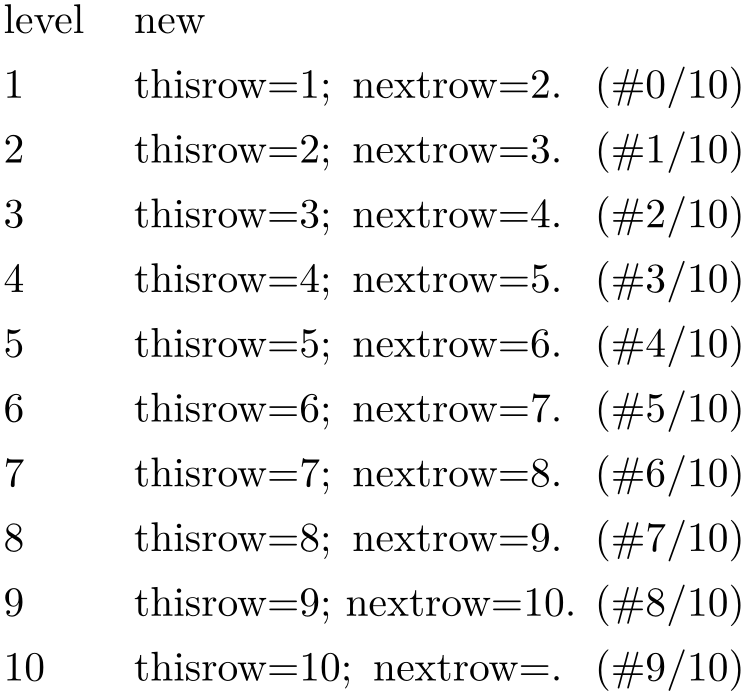
\pgfplotstableread{pgfplotstable.example1.dat}\loadedtable
\pgfplotstablecreatecol[
create col/assign/.code={%
\getthisrow{level}\entry
\getnextrow{level}\nextentry
\edef\entry{thisrow=\entry; nextrow=\nextentry.
(\#\pgfplotstablerow/\pgfplotstablerows)}%
\pgfkeyslet{/pgfplots/table/create col/next content}\entry
}]
{new}\loadedtable
\pgfplotstabletypeset[
column type=l,
columns={level,new},
columns/new/.style={string type}
]\loadedtable
There is one more specialty: you can use
columns={ column list
column list } to reduce the runtime complexity of this command. This works only if the
columns key is provided directly into
} to reduce the runtime complexity of this command. This works only if the
columns key is provided directly into
 options
options . In this case \thisrow and its variants are only defined
for those columns listed in the columns value.
. In this case \thisrow and its variants are only defined
for those columns listed in the columns value.
Currently, you can only access three values of one column at a time: the current row, the previous row and the next row. Access to arbitrary indices is not (yet) supported.
If you’d like to create a table from scratch using this command (or the related create on use simplification), take a look at \pgfplotstablenew.
The default implementation of assign is to produce empty strings. The default implementation of assign last is to invoke assign, so in case you never really use the next row’s value, you won’t need to touch assign last. The same holds for assign first.
-
/pgfplots/table/create on use/
 col name
col name /.style={
/.style={ create options
create options }
¶
}
¶
Allows “lazy
creation” of the column
 col name
col name . Whenever the column
. Whenever the column
 col name
col name is queried by name, for example in an
\pgfplotstabletypeset command, and such
a column does not exist already, it is created on the fly.
is queried by name, for example in an
\pgfplotstabletypeset command, and such
a column does not exist already, it is created on the fly.
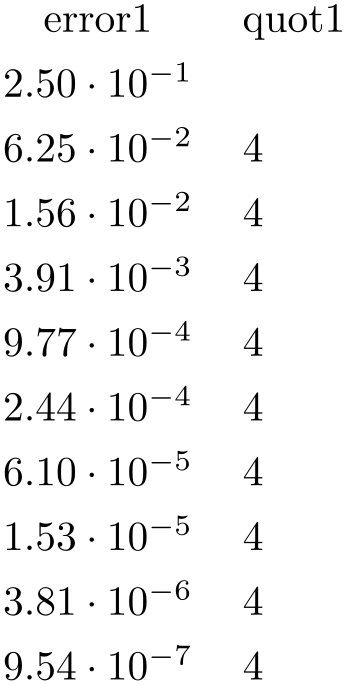
% requires \usepackage{array}
\pgfplotstableset{% could be used in preamble
create on use/quot1/.style=
{create col/quotient={error1}}}
\pgfplotstabletypeset[
columns={error1,quot1},
columns/error1/.style={sci,sci
zerofill},
columns/quot1/.style={dec sep align}]
{pgfplotstable.example1.dat}
The example above queries quot1 which does not yet exist in the input file. Therefore, it is checked whether a create on use style for quot1 exists. This is the case, so it is used to create the missing column. The create col/quotient key is discussed below; it computes quotients of successive rows in column error1.
A create on use specification is translated into
\pgfplotstablecreatecol[ create options
create options ]{
]{ col name
col name }{
}{ the table
the table },
},
or, equivalently, into
\pgfplotstablecreatecol[create on
use/ col name
col name ]{
]{ col name
col name }{
}{ the table
the table }.
}.
This feature allows some laziness, because you can omit the lengthy table modifications. However, laziness may cost something: in the example above, the generated column will be lost after returning from \pgfplotstabletypeset.
The create on use has higher priority than alias.
In case
 col name
col name contains characters which are required for key settings, you need to use braces around it: “create on use/{name=wi/th,special}/.style={...}”.
contains characters which are required for key settings, you need to use braces around it: “create on use/{name=wi/th,special}/.style={...}”.
More examples for create on use are shown below while discussing the available column creation styles.
Note that create on use is also available within pgfplots, in \addplot table when used together with the read completely key.
6.3.3Predefined Column Generation Methods¶
The following keys can be used in both \pgfplotstablecreatecol and the easier create on use frameworks.
6.3.3.1Acquiring Data Somewhere¶
-
/pgfplots/table/create col/set={
 value
value }
¶
}
¶
A style for use in
column creation context which creates a new column and writes
 value
value into each new cell. The value is written as string (verbatim).
into each new cell. The value is written as string (verbatim).
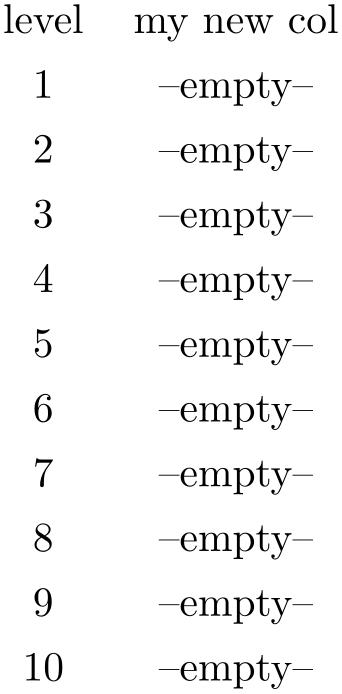
\pgfplotstableset{
create on use/my new col/.style={create col/set={--empty--}},
columns/my new col/.style={string type}
}
\pgfplotstabletypeset[
columns={level,my new
col},
]{pgfplotstable.example1.dat}
-
/pgfplots/table/create col/set list={
 comma-separated-list
comma-separated-list }
¶
}
¶
A style for use in
column creation context which creates a new column consisting of the entries in
 comma-separated-list
comma-separated-list . The value is written as string (verbatim).
. The value is written as string (verbatim).
The
 comma-separated-list
comma-separated-list is processed via TikZ’s
\foreach command, that means you can use
... expressions to provide number (or character) ranges.
is processed via TikZ’s
\foreach command, that means you can use
... expressions to provide number (or character) ranges.
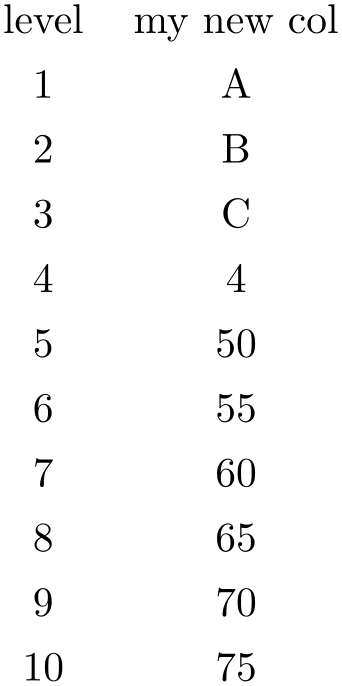
\pgfplotstableset{
create on use/my new col/.style={
create col/set list={A,B,C,4,50,55,...,100}},
columns/my new col/.style={string type}
}
\pgfplotstabletypeset[
columns={level,my new
col},
]{pgfplotstable.example1.dat}
The new column will be padded or truncated to the required number of rows. If the list does not contain enough elements, empty cells will be produced.
-
/pgfplots/table/create col/copy={
 column name
column name }
¶
}
¶
A style for use in
column creation context which simply copies the existing column
 column name
column name .
.
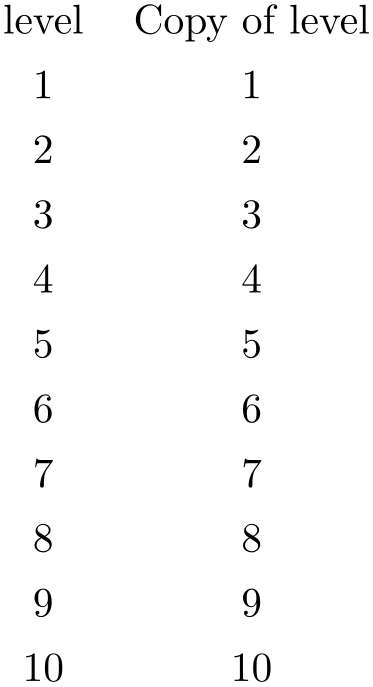
\pgfplotstableset{
create on use/new/.style={create col/copy={level}}
}
\pgfplotstabletypeset[
columns={level,new},
columns/new/.style={column name=Copy of level}
]{pgfplotstable.example1.dat}
-
/pgfplots/table/create col/copy column from table={
 file name or \macro
file name or \macro }{
}{ column name
column name }
¶
}
¶
A
style for use in column creation context which creates a new column consisting of the entries in
 column name
column name of the provided table. The argument may be either a file name or an already loaded table (i.e. a
of the provided table. The argument may be either a file name or an already loaded table (i.e. a
 \macro
\macro as returned by \pgfplotstableread).
as returned by \pgfplotstableread).
You can use this style, possibly combined with \pgfplotstablenew, to merge one common sort of column from different tables into one large table.
The cell values are written as string (verbatim).
The new column will be padded or truncated to the required number of rows. If the list does not contain enough elements, empty cells will be produced.
6.3.3.2Mathematical Operations¶
-
/pgf/fpu=true|false (initially true)
Before we start to describe the column generation methods, one word about the math library. The core is always the pgf math engine written by Mark Wibrow and Till Tantau. However, this engine has been written to produce graphics and is not suitable for scientific computing.
I added a high-precision floating point library to pgf which will be part of releases newer than pgf \(2.00\). It offers the full range of IEEE double precision computing in TeX. This FPU is also part of PgfplotsTable, and it is activated by default for create col/expr and all other predefined mathematical methods.
The FPU won’t be active for newly defined numerical styles (although it is active for the predefined mathematical expression parsing styles like create col/expr). If you want to add own routines or styles, you will need to use
in order to activate the extended precision. The standard math parser is limited to fixed point numbers in the range of \(\pm 16384.00000\).
-
/pgfplots/table/create col/expr={
 math expression
math expression }
¶
}
¶
A style for use in
\pgfplotstablecreatecol which uses
 math expression
math expression to assign contents for the new column.
to assign contents for the new column.
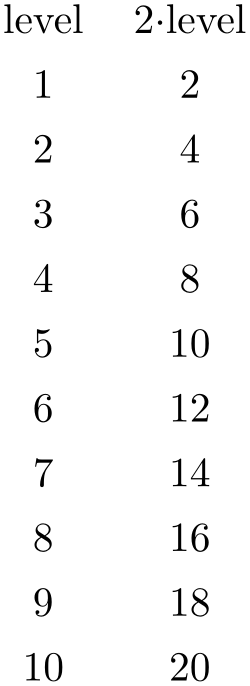
\pgfplotstableset{
create on use/new/.style={
create col/expr={\thisrow{level}*2}}
}
\pgfplotstabletypeset[
columns={level,new},
columns/new/.style={column name=$2\cdot $level}
]{pgfplotstable.example1.dat}
The macros \thisrow{ col name
col name } and \nextrow{
} and \nextrow{ col name
col name } can be used to use values of the existing table.
} can be used to use values of the existing table.
Please see \pgfplotstablecreatecol for more information.
The expr style initializes
\pgfmathaccuma to 0 before its first
column. Whenever it computes a new column value, it redefines
\pgfmathaccuma to be the result. That means you
can use \pgfmathaccuma inside of
 math expression
math expression to accumulate columns. See
create col/expr accum for more
details.
to accumulate columns. See
create col/expr accum for more
details.
About the precision and number range:
Starting with version 1.2, expr uses a floating point unit. The FPU provides the full data range of scientific computing with a relative precision between \(10^{-4}\) and \(10^{-6}\). The /pgf/fpu key provides some more details.
The math parser of pgf, combined with the FPU, provides the following function and operators:
+, -, *, /, abs, round, floor, mod, <, >, max, min, sin, cos, tan, deg (conversion from radians to degrees), rad (conversion from degrees to radians), atan, asin, acos, cot, sec, cosec, exp, ln, sqrt, the constanst pi and e, ^ (power operation), factorial107, rand (random between \(-1\) and \(1\) following a uniform distribution), rnd (random between \(0\) and \(1\) following a uniform distribution), number format conversions hex, Hex, oct, bin and some more. The math parser has been written by Mark Wibrow and Till Tantau, the FPU routines have been developed as part of pgfplots. The documentation for both parts can be found in the PGF/TikZ manual. Attention: Trigonometric functions work with degrees, not with radians, unless trig format is reconfigured!
-
/pgfplots/table/create col/expr accum={
 math expression
math expression }{
}{ accum initial
accum initial }
¶
}
¶
A variant of
create col/expr which also allows to
define the initial value of \pgfmathaccuma. The case
 accum initial
accum initial =0 is equivalent to expr={
=0 is equivalent to expr={ math expression
math expression }.
}.
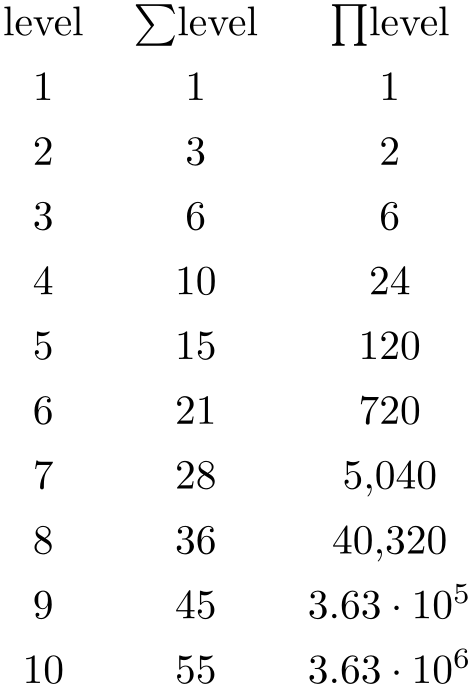
\pgfplotstableset{
create on use/new/.style={
create col/expr={\pgfmathaccuma +
\thisrow{level}}},
create on use/new2/.style={
create col/expr accum={\pgfmathaccuma *
\thisrow{level}}{1}% <- start with `1'
}
}
\pgfplotstabletypeset[
columns={level,new,new2},
columns/new/.style={column name=$\sum$level},
columns/new2/.style={column name=$\prod$level}
]{pgfplotstable.example1.dat}
The example creates two columns: the new column is just the sum of each value in the
 level
level column (it employs the default
\pgfmathaccuma=0). The new2 column
initializes \pgfmathaccuma=100 and then
successively subtracts the value of
column (it employs the default
\pgfmathaccuma=0). The new2 column
initializes \pgfmathaccuma=100 and then
successively subtracts the value of
 level
level .
.
-
/pgfplots/table/create col/quotient={
 column name
column name }
¶
}
¶
A style for use in
\pgfplotstablecreatecol which
computes the quotient \(c_i := m_{i-1} / m_i\) for every entry \(i = 1,\dotsc , (n-1)\) in the column identified with
 column name
column name . The first value \(c_0\) is kept empty.
. The first value \(c_0\) is kept empty.
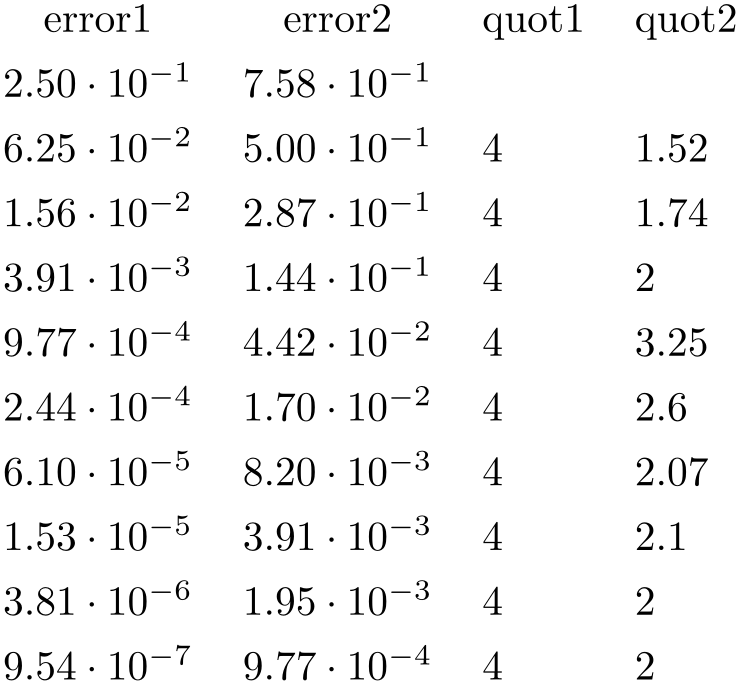
% requires \usepackage{array}
\pgfplotstableset{% configuration, for example, in preamble:
create on use/quot1/.style={create col/quotient=error1},
create on use/quot2/.style={create col/quotient=error2},
columns={error1,error2,quot1,quot2},
%
% display styles:
columns/error1/.style={sci,sci
zerofill},
columns/error2/.style={sci,sci
zerofill},
columns/quot1/.style={dec sep align},
columns/quot2/.style={dec sep align}
}
\pgfplotstabletypeset{pgfplotstable.example1.dat}
This style employs methods of the floating point unit, that means it works with a relative precision of about \(10^{-7}\) (\(7\) significant digits in the mantissa).
-
/pgfplots/table/create col/iquotient={
 column name
column name }
¶
}
¶
Like create col/quotient, but the quotient is inverse.
-
/pgfplots/table/create col/dyadic refinement rate={
 column name
column name }
¶
}
¶
A
style for use in
\pgfplotstablecreatecol which
computes the convergence rate \(\alpha \) of the data in column
 column name
column name . The contents of
. The contents of
 column name
column name is assumed to be something like \(e_i(h_i) = O(h_i^\alpha )\). Assuming a dyadic refinement relation from one row to the
next, \(h_i = h_{i-1}/2\), we have \(h_{i-1}^\alpha / (h_{i-1}/2)^\alpha = 2^\alpha \), so we get \(\alpha \) using
is assumed to be something like \(e_i(h_i) = O(h_i^\alpha )\). Assuming a dyadic refinement relation from one row to the
next, \(h_i = h_{i-1}/2\), we have \(h_{i-1}^\alpha / (h_{i-1}/2)^\alpha = 2^\alpha \), so we get \(\alpha \) using
\[ c_i := \log _2\left ( \frac {e_{i-1}}{e_i} \right ). \]
The first value \(c_0\) is kept empty.
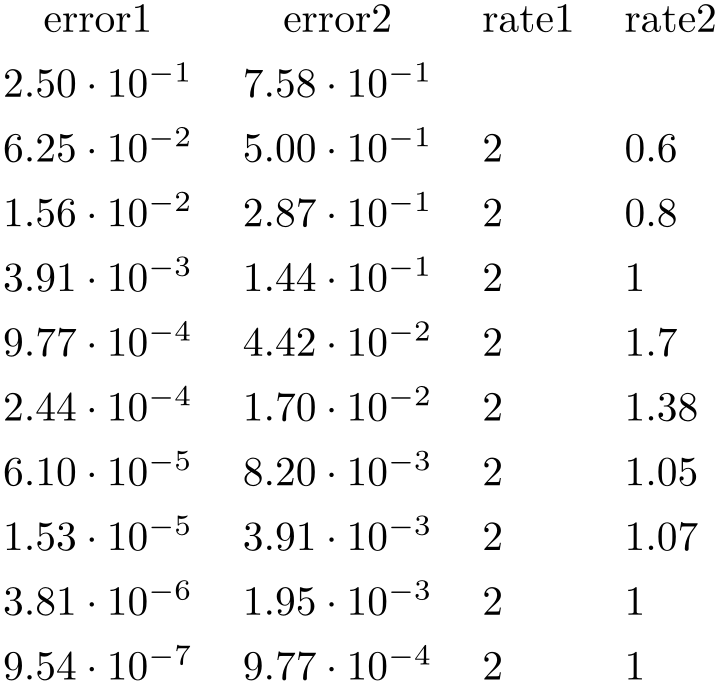
% requires \usepackage{array}
\pgfplotstabletypeset[% here, configuration
options apply only to this single statement:
create on use/rate1/.style={create col/dyadic refinement rate={error1}},
create on use/rate2/.style={create col/dyadic refinement rate={error2}},
columns={error1,error2,rate1,rate2},
columns/error1/.style={sci,sci
zerofill},
columns/error2/.style={sci,sci
zerofill},
columns/rate1/.style={dec sep align},
columns/rate2/.style={dec sep align}]
{pgfplotstable.example1.dat}
This style employs methods of the floating point unit, that means it works with a relative precision of about \(10^{-6}\) (\(6\) significant digits in the mantissa).
-
/pgfplots/table/create col/idyadic refinement rate={
 column name
column name }
¶
}
¶
As create col/dyadic refinement rate, but the quotient is inverse.
-
/pgfplots/table/create col/gradient={
 col x
col x }{
}{ col y
col y }
¶
}
¶
-
/pgfplots/table/create col/gradient loglog={
 col x
col x }{
}{ col y
col y }
¶
}
¶
-
/pgfplots/table/create col/gradient semilogx={
 col x
col x }{
}{ col y
col y }
¶
}
¶
-
/pgfplots/table/create col/gradient semilogy={
 col x
col x }{
}{ col y
col y }
¶
}
¶
A style
for \pgfplotstablecreatecol which
computes piecewise gradients \((y_{i+1} - y_i) / (x_{i+1} - x_i )\) for each row. The \(y\) values are taken out of column
 col y
col y and the \(x\) values are taken from
and the \(x\) values are taken from
 col y
col y .
.
The logarithmic variants apply the natural logarithm, \(\log (\cdot )\), to its argument before starting to compute differences. More precisely, the loglog variant applies the logarithm to both \(x\) and \(y\), the semilogx variant applies the logarithm only to \(x\) and the semilogy variant applies the logarithm only to \(y\).
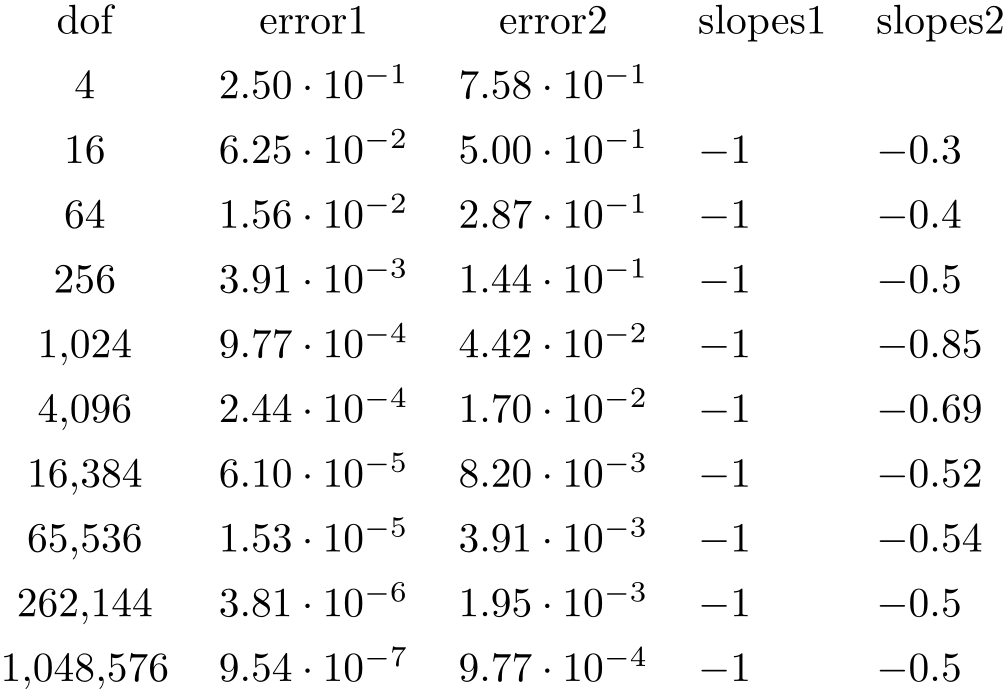
% requires \usepackage{array}
\pgfplotstableset{% configuration, for example in preamble:
create on use/slopes1/.style={create col/gradient loglog={dof}{error1}},
create on use/slopes2/.style={create col/gradient loglog={dof}{error2}},
columns={dof,error1,error2,slopes1,slopes2},
% display styles:
columns/dof/.style={int detect},
columns/error1/.style={sci,sci
zerofill},
columns/error2/.style={sci,sci
zerofill},
columns/slopes1/.style={dec sep align},
columns/slopes2/.style={dec sep align}
}
\pgfplotstabletypeset{pgfplotstable.example1.dat}

% requires \usepackage{array}
\pgfplotstableset{% configuration, for example in preamble:
create on use/slopes1/.style={create col/gradient semilogy={level}{error1}},
columns={level,error1,slopes1},
% display styles:
columns/level/.style={int
detect},
columns/error1/.style={sci,sci
zerofill,sci subscript},
columns/slopes1/.style={dec sep align}
}
\pgfplotstabletypeset{pgfplotstable.example1.dat}
This style employs methods of the floating point unit, that means it works with a relative precision of about \(10^{-6}\) (\(6\) significant digits in the mantissa).
-
/pgfplots/table/create col/linear regression={
 key-value-config
key-value-config }
}
Computes a linear (least squares) regression \(y(x) = a \cdot x + b\) using the sample data \((x_i,y_i)\) which has to be
specified inside of
 key-value-config
key-value-config .
.

% load table from somewhere:
\pgfplotstableread{
x
y
1 1
2 4
3 9
4 16
5 25
6 36
}\loadedtbl
% create the `regression' column:
\pgfplotstablecreatecol[linear regression]
{regression}
{\loadedtbl}
% store slope
\xdef\slope{\pgfplotstableregressiona}
\pgfplotstabletypeset\loadedtbl\\
The slope is `\slope'.
The example above loads a table from inline data, appends a column named ‘regression’ and typesets
it. Since no
 key-value-config
key-value-config has been provided, x=[index]0 and
y=[index]1 will be used. The \xdef\slope{...} command
stores the ‘\(a\)’ value of the regression line into a newly defined macro ‘\slope’.108
has been provided, x=[index]0 and
y=[index]1 will be used. The \xdef\slope{...} command
stores the ‘\(a\)’ value of the regression line into a newly defined macro ‘\slope’.108
The complete documentation for this feature has been moved to pgfplots due to its close relation to plotting. Please refer to the pgfplots manual coming with this package.
-
/pgfplots/table/create col/function graph cut y={
 cut value
cut value }{
}{ common options
common options }{
}{ one key–value set for each plot
one key–value set for each plot }
¶
}
¶
-
• table={
 table file or \macro
table file or \macro }: either a file name or an already loaded table where to get the data points,
}: either a file name or an already loaded table where to get the data points,
-
• foreach={
 \foreach loop head
\foreach loop head }{
}{ file name pattern
file name pattern } This somewhat advanced syntax allows to collect tables in a loop automatically:
} This somewhat advanced syntax allows to collect tables in a loop automatically:
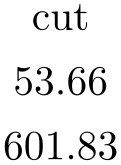
\pgfplotstablenew[% same as above...create on use/cut/.style={create col/function graph cut y={2.5e-4}% search for fixed L2 = 2.5e-4{x=Basis,y=L2,ymode=log,xmode=log,foreach={\i in {1,2}}{plotdata/newexperiment\i.dat}}%{}% just leave this empty.},columns={cut}]{2}\loadedtable% Show the data:\pgfplotstabletypeset{\loadedtable}PgfplotsTable will call \foreach
 \foreach loop head
\foreach loop head and it will expand
and it will expand
 file name pattern
file name pattern for every iteration. For every iteration, a simpler list entry of the form
for every iteration. For every iteration, a simpler list entry of the form
table={
 expanded pattern
expanded pattern },x={
},x={ value of x
value of x },y={
},y={ value of y
value of y }
}
will be generated.
It is also possible to provide foreach= inside of
 one key–value set for each plot
one key–value set for each plot . The foreach key takes precedence over
table. Details about the accepted syntax of
\foreach can be found in the
pgf manual.
. The foreach key takes precedence over
table. Details about the accepted syntax of
\foreach can be found in the
pgf manual.
A
specialized style for use in
create on use statements which computes
cuts of (one or more) discrete plots \(y(x_1), \dotsc , y(x_N)\) with a fixed
 cut value
cut value . The \(x_i\) are written into the table’s cells.
. The \(x_i\) are written into the table’s cells.
In a cost–accuracy plot, this feature allows to extract the cost for fixed accuracy. The dual feature with cut x allows to compute the accuracy for fixed cost.

% Preamble: \pgfplotsset{width=7cm,compat=1.18}
\pgfplotstablenew[
create on use/cut/.style={create col/function graph cut y=
{2.5e-4} % search for fixed L2 = 2.5e-4
{x=Basis,y=L2,ymode=log,xmode=log} % double log, each
function is L2(Basis)
% now, provide each single function f_i(Basis):
{{table=plotdata/newexperiment1.dat},{table=plotdata/newexperiment2.dat}}
},
columns={cut}]
{2}
\loadedtable
% Show the data:
\pgfplotstabletypeset{\loadedtable}
\begin{tikzpicture}
\begin{loglogaxis}
\addplot table[x=Basis,y=L2] {plotdata/newexperiment1.dat};
\addplot table[x=Basis,y=L2] {plotdata/newexperiment2.dat};
\draw[blue!30!white] (1,2.5e-4) -- (1e5,2.5e-4);
\node[pin=-90:{$x=53.66$}] at
(53.66,2.5e-4) {};
\node[pin=45:{$x=601.83$}] at
(601.83,2.5e-4) {};
\end{loglogaxis}
\end{tikzpicture}
In the example above, we are searching for \(x_1\) and \(x_2\) such that \(f_1(x_1) = 2.5\cdot 10^{-4}\) and \(f_2(x_2)
=2.5\cdot 10^{-4}\). On the left is the automatically computed result. On the right is a problem illustration with proper
annotation using
pgfplots to visualize the results. The
 cut value
cut value is set to 2.5e-4. The
is set to 2.5e-4. The
 common options
common options contain the problem setup; in our case logarithmic scales and column names. The third argument is a comma-separated-list.
Each element \(i\) is a set of keys describing how to get \(f_i(\cdot )\).
contain the problem setup; in our case logarithmic scales and column names. The third argument is a comma-separated-list.
Each element \(i\) is a set of keys describing how to get \(f_i(\cdot )\).
During both
 common options
common options and
and
 one key–value set for each plot
one key–value set for each plot , the following keys can be used:
, the following keys can be used:
The keys xmode and ymode can take either log or linear. All mentioned keys have the common key path
/pgfplots/table/create col/function graph cut/.
-
/pgfplots/table/create col/function graph cut x={
 cut value
cut value }{
}{ common options
common options }{
}{ one key–value set for each plot
one key–value set for each plot }
¶
}
¶